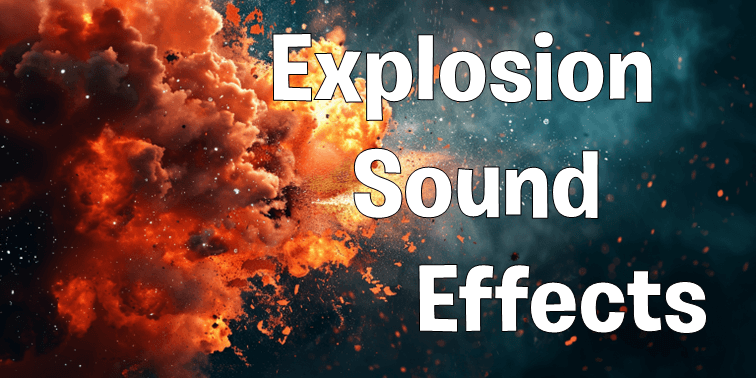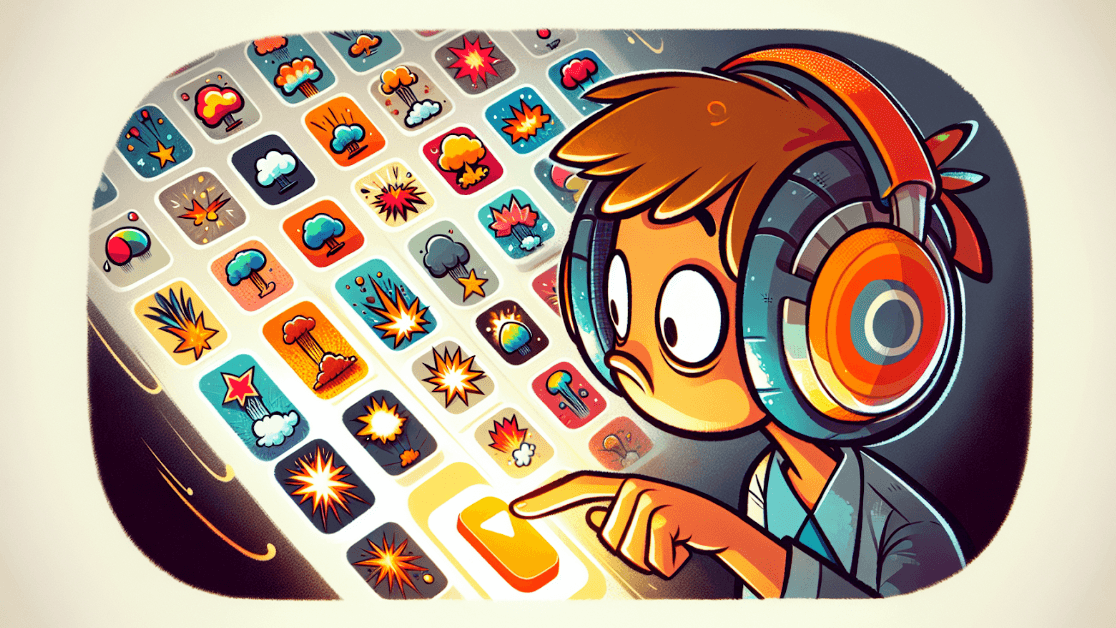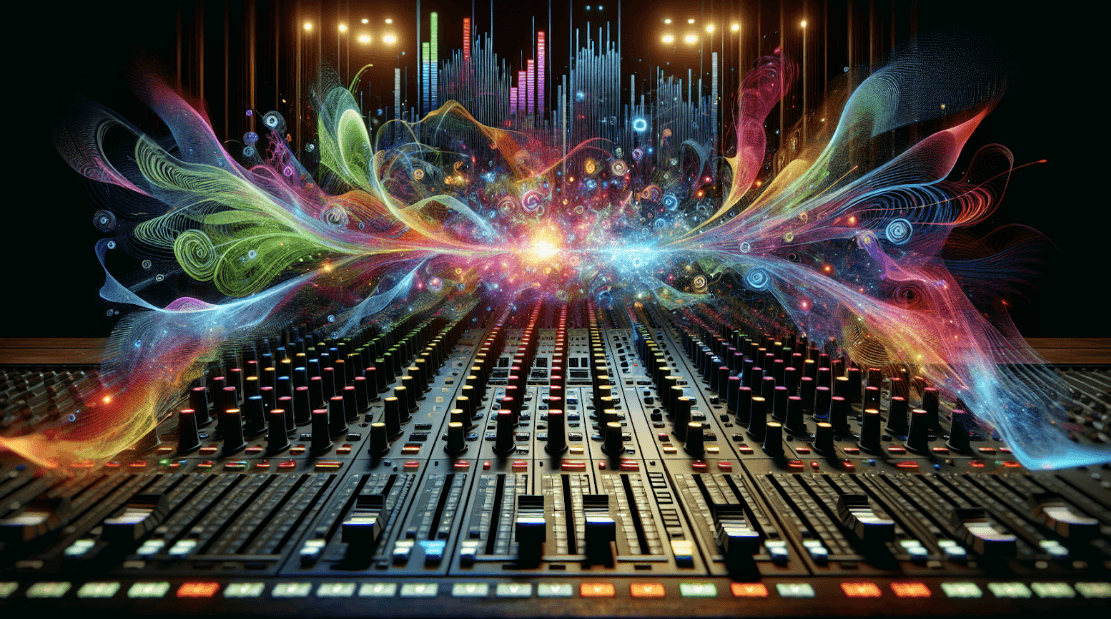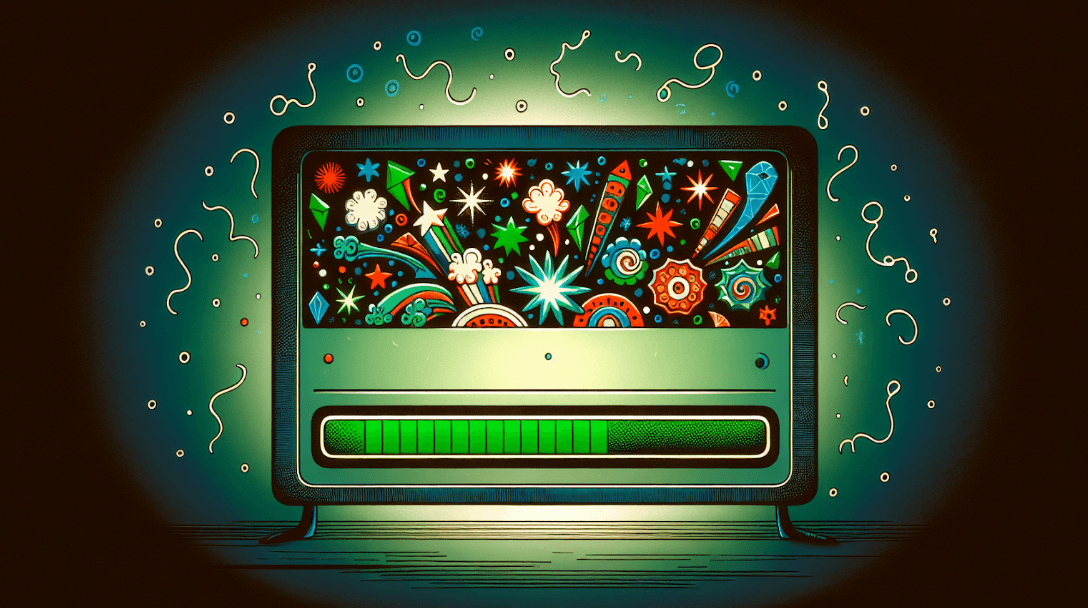Download Free Explosion Sound Effects
Last UpdatedMay 13, 2024
by
Anthony Gallo

Seeking to elevate your project with free explosion sound effects?
In this article, I'll dive straight into the essentials of using, sourcing, and downloading free, high-quality MP3 explosion sound effects that pack a punch. 💥
From capturing the intensity of the blast to ensuring a seamless integration with your visuals, we provide the guidance you need to bring your project’s explosive moments to life without any fuss or fees.
Get started with 10 FREE explosion sound effects right now! 👇
Key Takeaways
- High-quality free explosion sound effects are vital for audience immersion and narrative authenticity in films and video games, with different types and creative uses enhancing the storytelling experience.
- Royalty-free explosion sound effects libraries offer a cost-effective solution for content creators, with a variety of sounds available and the importance of understanding legal usage to avoid copyright issues.
Exploring the Impact of Explosion Sound Effects
When it comes to engaging entertainment, the devil is in the details—or, more aptly, in the sound.
High-quality free explosion sound effects are the unsung heroes that transform a visual experience into a full-bodied adventure. In film and video games, these sounds are the cornerstone of audience immersion, transforming digital pixels into palpable reality.
Whether it’s the deafening roar of a detonation or the subtle crumble of falling debris, explosion sound effects play a pivotal role in storytelling, adding a layer of authenticity and excitement that can make or break the audience’s investment in the narrative.
Types of Explosions
Dive into the world of explosion sound effects, and you’ll discover a vast landscape of audio, ranging from the distant rumble of a boom to the sharp intensity of a close-up blast.
Sound libraries categorize these sounds by distance, explosive material, and environment, offering options like ‘Long Tail Explosion’ for dramatic resonance or ‘Explosive Space Launch’ for a touch of the otherworldly.
The type of explosion you choose can carry your audience miles away or set them at the epicenter of the action, each one tailored to the unique narrative of your scene.
Using Explosion Sounds Creatively
The creative use of explosion sound effects can amplify a scene’s intensity, marking moments of climax and transformation with a bang.
By layering different explosion sound effects, tweaking vocal effects, and varying the intensity, content creators can craft a soundscape that’s as impactful as it’s convincing.
The key is to match the auditory boom with the narrative’s heartbeat: timing, context, and the emotional response you seek to evoke are all vital components in this high-stakes game of royalty free sound effects.
The Role of Audio Quality
The fidelity of an explosion sound effect is a direct conduit to its believability.
High audio quality isn’t just desirable, it’s essential for maintaining the realism that keeps viewers immersed in the world you’ve created.
With the right recording equipment, techniques, and a well-mixed audio track, the clarity of your explosion can complement the visuals without overwhelming them.
The right use of audio effects like saturation, distortion, and compression can make the difference between an explosion that fizzles out and one that resonates with explosive clarity.
Foley sounds, such as the anticipatory whoosh of air before the blast and the crackle of debris, can further enhance the authenticity of your explosion sound effects.
Finding the Perfect Explosion Sound

Embarking on the quest for the perfect explosion sound is akin to choosing the right spice for a gourmet meal—it has to complement the dish, or, in this case, the scene.
The setting, the emotional impact, and even the genre of your project are the guiding stars on this journey.
Are you looking to elicit a gasp or a shudder from your audience at the moment of impact? The realism or stylized nature of the explosion, the scale of the visual spectacle, and the intensity of the surrounding action all play a role in your selection process.
Whether it’s the gritty realism of a battlefield or the exaggerated flair of a classic meme sound effect, the explosion sound effect you choose must resonate with both the visual style and the setting of your scene.
To achieve that sweet spot, consider the unique features of explosion sounds like duration, echo, and frequency range—they’re the ingredients that will help you find the auditory match for your project’s visual explosion.
Sound Duration Variations
The length of an explosion sound effect is a delicate balance you must strike with precision.
Too short, and the impact feels underwhelming; too long, and the effect can lose its punch.
It’s a dance of duration where each sound must be carefully adjusted to fit the narrative moment, ensuring that key elements like dialogue remain in the spotlight.
The audio mix should wrap around these moments like a tailor-made suit, cut to perfection for maximum impact, with a precision of 0 01, an even finer accuracy of 0 02, the ultimate level of detail at 0 03, an exceptional refinement at 0 05, a remarkable finesse at 0 06, and an unparalleled precision at 0 08.
Matching Sounds with Visuals
Achieving a seamless marriage between sound and visuals is an art form.
The explosion sound that echoes through your audience’s speakers must be a natural extension of what they see on screen. Like a skilled puppeteer, you control the strings of auditory and visual elements, ensuring that the intensity and style of the explosion sounds are in lockstep with the cinematic action.
Adding nuanced sounds, such as the whizzing of shrapnel, can elevate the perceived danger and immerse viewers deeper into the experience, an approach that movies like ‘Mad Max’ have mastered to great effect.
Layering Sounds for Complexity
Just as a chef layers flavors to create a complex dish, sound designers layer different samples to construct an explosion sound that’s rich with depth. Combining:
- kick drums
- distortion
- phasers
- reverb
can yield a soundscape that’s as intricate as it is explosive. In the pursuit of realism, integrating Foley sounds and adhering to audio mixing guidelines can transform a flat bang into a dynamic auditory event.
Even mouth-made explosion sounds, when layered, can serve as a robust base for the more nuanced elements of an explosion, creating an effect that’s both believable and dynamic.
To further enrich the experience, incorporating diverse elements from sound packs, like sub impacts and the scattering of debris, can make all the difference.
Royalty-Free Explosion Sound Libraries
Stepping into the arena of royalty-free explosion sound libraries is like discovering a treasure trove for the cost-conscious creator.
Here, the allure of free explosion sound effects comes without the shadow of ongoing royalty expenses, offering a budget-friendly solution that doesn’t skimp on quality.
These libraries are a cornucopia of sounds, providing audio for every conceivable scenario and ensuring that creators have the necessary tools for their storytelling arsenal.
Choosing to financially support sound designers through one-time purchase fees or subscription services not only compensates these artists but also gives you access to a diverse range of sounds, like those in the ‘Explosion Sound Pack’, which offers everything from debris-laden detonations to bursts that mimic the sounds of metal or water.
What is Royalty Free?
Navigating the world of royalty-free content might seem daunting, but it’s essentially about freedom—once you’ve made an initial payment, you’re free to use the content repeatedly without additional royalties.
However, royalty-free doesn’t mean copyright-free; you’re leasing the sounds based on specific terms that allow you to use them without ongoing fees.
Artists continue to earn through license sales and other revenue streams like streaming services, ensuring that their creative output is a sustainable venture.
With a range of costs, there’s high-quality royalty-free music and sound effects accessible for every budget, although you must heed the terms and conditions to stay on the right side of legality.
Top Sources for Free Explosion Sounds
For those in search of free explosion sound effects, the digital landscape is dotted with resources ready to be mined.
Websites like Content Creator Templates offer an array of free explosion sounds, from the sharp snap of a ‘Mid Distant Bomb’ to the expansive roar of a ‘Strong Explosion Blast’.
The variety provided by these websites can be a game-changer for creators looking to inject their projects with high-quality audio without breaking the bank.
How to Download and Implement Explosion Sounds

Once you’ve found the explosive sounds that will propel your project to new heights, the next step is downloading and integrating them into your masterpiece. Here’s how:
- Pinpoint a reputable source with a quality library of sound effects.
- Use filters to refine your search, targeting the type of explosion that best suits your needs.
- Follow the website’s download instructions carefully, which may involve account creation or agreeing to licensing terms.
Before hitting that download button, ensure you select the correct audio format, such as WAV or MP3, and consider the bit rate and sample rate to guarantee quality and software compatibility.
To bring these sounds into your project, import them into your audio or video editing software, placing them on a track reserved for sound effects, ready to be synced with your visual content.
Choosing the Right Format
In the digital realm of sound design, the format of your audio files can make all the difference. WAV is a go-to for its editing ease, while OGG offers a balance of quality with smaller files. MP3, despite its ubiquity, comes with licensing considerations.
For motion graphics and projects demanding the highest fidelity, uncompressed formats like WAVE or AIFF are the gold standard, ensuring no loss of quality that could occur with compressed formats.
Integrating Sounds into Your Project
The real magic happens when integrating the downloaded explosion sounds with your project. It’s essential to ensure format compatibility and consider the scope of audio post-production.
Once you’ve selected the perfect sound, save and export it in a format tailored to your needs. Syncing the sound effect with your video is a precise operation, executed within video editing software to guarantee the explosion aligns perfectly with the on-screen action.
Enhancing Your Audio with Additional Effects

With the raw explosion sounds in place, the next step is to transform them into a spectacle for the ears. Adobe Audition is a powerful ally in this endeavor, providing the tools needed to edit and enhance your sound effects for maximum impact.
Even your own voice can be morphed into a convincing explosion with the software’s capabilities, offering a personalized touch to your project’s auditory landscape.
Adding Reverb for Depth
Reverb is the spice that can elevate an explosion sound from flat to three-dimensional, emulating the acoustical effects of space and movement.
By automating reverb, you can mirror character movements in a scene, adding depth and a touch of realism. Pairing this automation with equalization maintains clarity while preserving the sound’s dimensional quality.
Stereo imaging plugins can also expand the perceived spatial position of an explosion, broadening its sound field within the mix without altering its place.
Mixing and Mastering Tips
In the intricate dance of sound mixing, explosion effects must harmonize with dialogue and music, ensuring a balanced auditory experience.
To achieve this, it’s crucial to maintain peak intensity levels of explosion sound effects around -3dB to -2dB, creating a powerful but aligned impact that meets broadcast standards.
Shaping the deeper impact layers with EQ can enhance the perceived size and power of your explosion, making it a formidable presence in the mix.
Compression is your ally in delivering a consistent and punchy output, maintaining control over the dynamic range to prevent distortion or overshadowing of other mix elements.
Utilizing EQ for Clarity
Equalization is the fine-tuning tool that ensures each explosion sound effect strikes the right chord within the frequency spectrum.
It allows you to highlight desired frequencies and avoid muddying the audio landscape with overlapping sounds, thus ensuring clarity and distinction for each explosion.
When combined with compression and reverb, EQ can control the dynamic range, shape the depth of explosions, and position them within a spatial context that feels authentic and immersive.
Realistic Explosion Sound Design
The pursuit of creating realistic explosion sounds is both a science and an art. This process involves finding the right balance of low and high frequencies to accurately depict the power and impact of an explosion.
It’s about capturing the essence of the initial blast, the crackling burst, and the rolling echo—elements that make the difference between a sound that’s simply loud and one that feels true to life.
Considering the environment in which the explosion occurs is also crucial, as it will influence the echo and reverb characteristics of the sound, making it resonate with the setting.
Layering different sound samples adds depth and complexity, while digital manipulation techniques such as pitch shifting and time stretching fine-tune the sound to match the desired intensity and scale.
High-quality sampling is essential to capture the audio fidelity needed for convincing explosion effects, and when all these elements come together, the result is an explosion sound that can stand up to the most discerning ear.
Capturing the Essence of an Explosion
To capture the essence of an explosion, sound designers blend various sounds that represent the main explosion, the resultant shockwave, and the sounds of debris settling.
They use layering of different kick drum samples and apply EQ adjustments and distortion within a digital audio workstation to craft custom explosion sounds that resonate with authenticity.
Reverb is then applied to make the sounds believable by simulating the effects of space and environment around the explosion.
Foley Artistry for Debris and Aftermath
Foley artistry is a vital component in the realism of explosion sound effects. Everyday items are used ingeniously to mimic the chaos of debris and aftermath.
Some examples of sounds created through foley artistry include:
- Grinding of rotating millstones
- Squeak of metal filing-cabinet drawers
- High-tech door slams
- Metal squeaks
These sounds contribute to the overall effect and realism of explosion sound effects.
The unique effects produced by incorporating household items into the foley process demonstrate the breadth of creative sound design, with layering different foley elements like whooshing air and high-frequency crackles adding layers of realism and complexity.
This manual performance of actions stays true to the traditional, analog methods of foley recording, ensuring that the sounds are as realistic as possible for the film scenes they accompany.
Synthesizing Unique Explosions
The construction of an explosion sound effect is defined by its three primary components:
- Transient: This is the initial sharp and sudden burst of sound that represents the initial impact or explosion.
- Body: This is the sustained portion of the sound that represents the main body or core of the explosion.
- Tail: This is the fading portion of the sound that represents the decay or aftermath of the explosion.
When these elements are synthesized with care and attention to detail, the resulting explosion is not only unique but also representative of the specific narrative it’s meant to enhance.
Summary
As we reach the end of our sonic journey, the power of high-quality explosion sound effects in storytelling is undeniable.
From understanding the variety of sounds available to the technical aspects of downloading and implementing them into your projects, we’ve explored how these auditory elements can make or break audience immersion.
Whether you’re layering sounds for complexity, mastering the art of foley, or enhancing audio with additional effects, the goal is always to create an experience that resonates with your audience.
Remember, the right explosion sound effect is the one that not only matches the visual spectacle but also captivates the listener, leaving a lasting impression that echoes beyond the screen.
Frequently Asked Questions
What makes an explosion sound effect high quality?
High-quality explosion sound effects are characterized by their clarity, balance of low and high frequencies, and ability to maintain realism and immersion within a project.
They are crafted using professional recording equipment, advanced audio editing techniques, and attention to detail in layering and audio effects such as reverb, EQ, and compression.
Can I use royalty-free explosion sounds in any type of project?
Yes, you can use royalty-free explosion sounds in different projects, as long as you follow the terms and conditions of the license, which may have restrictions regarding usage. Be mindful of the licensing terms.
How do I choose the right explosion sound for my scene?
To choose the right explosion sound for your scene, consider the visual style, setting, desired emotional response, and the scale of the explosion. Evaluate the sound's duration, echo, and frequency range to find the ideal match.
What are some common techniques for enhancing explosion sound effects?
To enhance explosion sound effects, you can use reverb for depth, equalization for clarity, mixing for balance, and compression for a punchy output. These techniques help create impactful and realistic explosion sounds.

Anthony Gallo
Anthony Gallo is the cofounder of ContentCreator.com and lead educator in the online course 14 Day Filmmaker, that has taught over 100,000 aspiring creators how to shoot & edit professional video content with PRO and SMARTPHONE cameras.
Having created content in a variety of industries including commercial advertising, weddings, music videos, and hundreds of youtube videos, Anthony has amassed over 50 million views online and is constantly looking for new and engaging ways to create content and help others master this amazing craft.